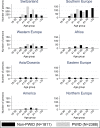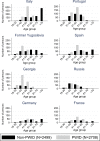Characteristics of Foreign-Born Persons in the Swiss Hepatitis C Cohort Study: Implications for Screening Recommendations
- PMID: 27227332
- PMCID: PMC4882055
- DOI: 10.1371/journal.pone.0155464
Characteristics of Foreign-Born Persons in the Swiss Hepatitis C Cohort Study: Implications for Screening Recommendations
Abstract
Background: Switzerland recommends individuals who originate from high-prevalence countries to be screened for hepatitis C virus (HCV) infection. However, not all these persons are equally at risk. We thus aimed to describe the number and characteristics of persons with HCV infection born outside of Switzerland.
Methods: We compared characteristics of anti-HCV-positive individuals in the Swiss Hepatitis C Cohort Study (SCCS) and of HCV cases reported to the Federal Office of Public Health (FOPH), with those of the general population in Switzerland. Persons who inject drugs (PWID) and persons who do not inject drugs (non-PWID) were compared by age groups for different countries of origin (represented by ≥1% of participants in the SCCS or FOPH).
Results: We included 4,199 persons from the SCCS and 26,610 cases from the FOPH. Both groups had similar characteristics. In both data sources non-PWID were more frequent in foreign-born than in Swiss-born persons (63% versus 34% in the SCCS). The only subgroup with a clearly higher proportion both in the SCCS and FOPH than in the general population were persons over 60 years from Italy and Spain, with a 3.7- and 2.8-fold increase in the SCCS. These persons were non-PWID (99%), less frequently HIV- and anti-HBc positive and more often female than PWID from Italy and Spain; cirrhosis at enrolment was frequent (31%). Their HCV genotypes were consistent with those observed in elderly non-PWID of their birth countries. In the FOPH a higher proportion than in the general population was also seen for cases from Georgia and Russia.
Conclusion: The identification of subgroups in which HCV infection is particularly frequent might allow for better targeting HCV screening among foreign-born persons in Switzerland and elsewhere.
Conflict of interest statement
Figures



Similar articles
-
Impact of geographic origin on access to therapy and therapy outcomes in the Swiss Hepatitis C Cohort Study.PLoS One. 2019 Jun 24;14(6):e0218706. doi: 10.1371/journal.pone.0218706. eCollection 2019. PLoS One. 2019. PMID: 31233524 Free PMC article.
-
Respondent-driven sampling for identification of HIV- and HCV-infected people who inject drugs and men who have sex with men in India: A cross-sectional, community-based analysis.PLoS Med. 2017 Nov 28;14(11):e1002460. doi: 10.1371/journal.pmed.1002460. eCollection 2017 Nov. PLoS Med. 2017. PMID: 29182638 Free PMC article.
-
Prevalence and risk factors associated with HIV/hepatitis B and HIV/hepatitis C co-infections among people who inject drugs in Mozambique.BMC Public Health. 2020 Jun 3;20(1):851. doi: 10.1186/s12889-020-09012-w. BMC Public Health. 2020. PMID: 32493347 Free PMC article.
-
Chronic hepatitis C virus infections in Switzerland in 2020: Lower than expected and suggesting achievement of WHO elimination targets.J Viral Hepat. 2023 Aug;30(8):667-684. doi: 10.1111/jvh.13842. Epub 2023 Jun 6. J Viral Hepat. 2023. PMID: 37278311
-
Global prevalence of HCV and/or HBV coinfections among people who inject drugs and female sex workers who live with HIV/AIDS: a systematic review and meta-analysis.Arch Virol. 2020 Sep;165(9):1947-1958. doi: 10.1007/s00705-020-04716-1. Epub 2020 Jul 2. Arch Virol. 2020. PMID: 32617764
Cited by
-
HCV disease burden and population segments in Switzerland.Liver Int. 2022 Feb;42(2):330-339. doi: 10.1111/liv.15111. Epub 2021 Dec 10. Liver Int. 2022. PMID: 34839578 Free PMC article.
-
Impact of geographic origin on access to therapy and therapy outcomes in the Swiss Hepatitis C Cohort Study.PLoS One. 2019 Jun 24;14(6):e0218706. doi: 10.1371/journal.pone.0218706. eCollection 2019. PLoS One. 2019. PMID: 31233524 Free PMC article.
-
Modelling the impact of different testing strategies for HCV infection in Switzerland.J Virus Erad. 2019 Nov 4;5(4):191-203. doi: 10.1016/S2055-6640(20)30036-4. J Virus Erad. 2019. PMID: 31754442 Free PMC article.
-
The Epidemiological Patterns of Hepatitis C in Lithuania: Changes in Surveillance from 2005 to 2018.Medicina (Kaunas). 2021 Oct 17;57(10):1120. doi: 10.3390/medicina57101120. Medicina (Kaunas). 2021. PMID: 34684157 Free PMC article.
References
-
- Sagmeister M, Renner EL, Mullhaupt B, Wong JB. Simulation of hepatitis C based on a mandatory reporting system. Eur J Gastroenterol Hepatol. 2002;14: 25–34 - PubMed
Publication types
MeSH terms
LinkOut - more resources
Full Text Sources
Other Literature Sources
Medical

